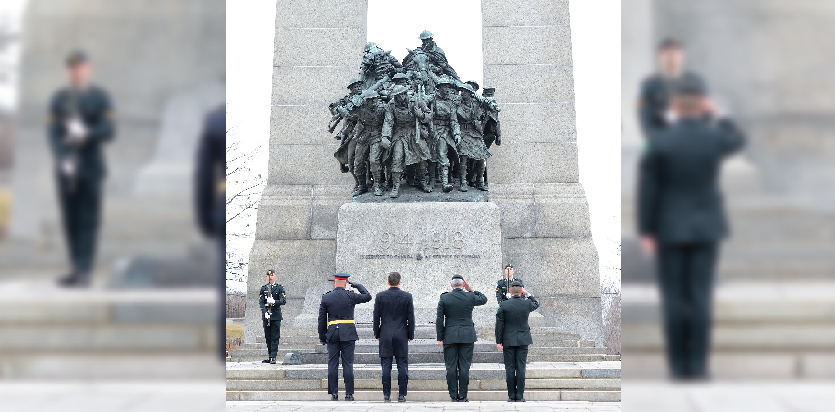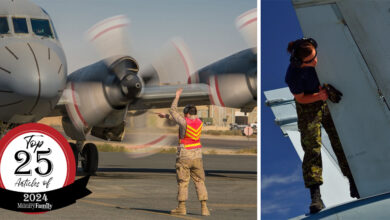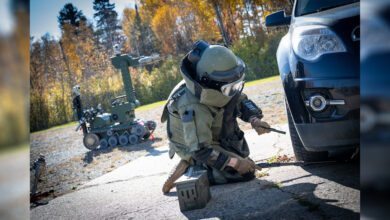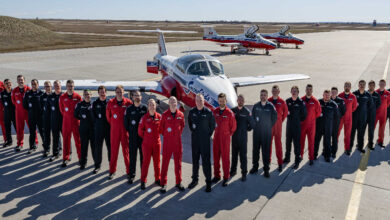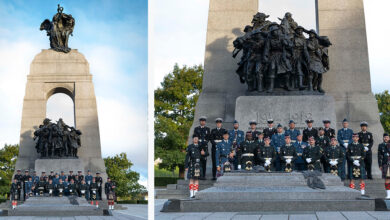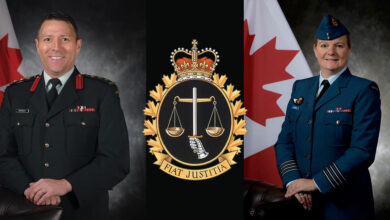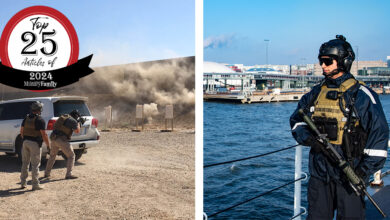Best of CMF MagazineDuty Calls
To Stand On Guard
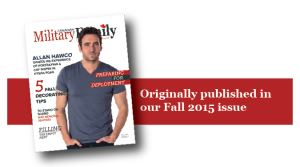 Standing sentry to Canada’s National War Memorial is considered a privilege to members of the Canadian Armed Forces.
Standing sentry to Canada’s National War Memorial is considered a privilege to members of the Canadian Armed Forces.
The days are long, the weather unpredictable and standing in one position for hours on end is hard on a soldier’s body, but the iconic sentries would not change anything about the job they do.
Highest Honour
“The first time I took sentry duty I was nominated by my chain of command. The second time I applied. It is the highest honour I have personally received while serving in the Canadian Armed Forces,” said Leading Seaman Rebecca Charlesworth. “It’s the idea of representing Vets, both past and present that makes being a sentry special.”
The unarmed sentries posted at the four corners of the National War Memorial are chosen through the National Sentries Program (NSP) for exemplifying outstanding performance of duty. The NSP draws sentries from the Royal Canadian Navy, Canadian Army, the Royal Canadian Air Force and the Canadian Special Operations Command. Special military anniversaries are also recognized with sentries from associated units, ships, squadrons, branches and Corps.
Charlesworth, who serves aboard HMCS Regina, is serving as a sentry in Ottawa for the second time. Normally, she is part of the Boatswain or Bos’n trade. Her job is varied including, working on the bridge as a helmsman or throttleman. She also uses lines, ropes and wires to transfer goods and equipment from ship to ship or ship to port. Bos’n on the bridge also maintain vigilance at sea.
With the mounting of sentries like Charlesworth at the Tomb of the Unknown Soldier, the NSP reinforces the Canadian commitment to remember and honour Canadians who served in both World Wars, as well as those who have contributed to Canada’s longstanding tradition of military excellence through to the present day.
Buses full of tourists, school children, serving members of the Canadian, Armed Forces and Vets visit the tomb daily. The sentries’ job is to reinforce public awareness that the Tomb of the Unknown Soldier is to be treated with dignity, tribute and respect.
“While standing sentry I watched an old Vet slowly make his way to the tomb. He needed assistance. It wasn’t easy for him to walk that far. But, when he got there he snapped his body to attention like he was 20 again. I’ll never forget his dignity in that moment,” said Charlesworth.
The sentries standing at the four corners of the monument are not permitted to speak with the public; however there is an additional sentry available to answer questions and provide assistance to duty sentries.
Charlesworth explained the sentry program offers a unique opportunity to represent the military in a public venue.
“Of course, it is an honour to stand sentry over the tomb, but I love third-man position when I get to talk to people about what the Canadian Armed Forces is all about.”
Members of the Forces perform sentry duty from 9:00 am to 5:00 pm from April 9 to November 10. In addition, sentries are also mounted to commemorate other significant military anniversaries between November and April.
Today
The 2015 National Sentry Program launched on April 9th, Vimy Ridge Day, at the National War Memorial in Ottawa. The Tomb of the Unknown Soldier stands directly in front of the National War Memorial, Canada’s most iconic and visible reminder of the service and sacrifice of members of the Canadian Armed Forces.
In a statement, at the launch of the 2015 season, the former Chief of the Defence Staff, General Tom Lawson said that, after the terrorist attack that killed Corporal Nathan Cirillo last October, the sentry duty has a deeper meaning for both the Canadian Armed Forces CAF and the Canadian public.
“The launch of the National Sentry Program in 2015 was especially important to the Canadian Armed Forces after the events of last fall. We remain resolute in paying tribute to our fallen and honour the service of our sentries in ensuring the Tomb of the Unknown Soldier is treated with dignity and respect.”
Posting sentries at the Tomb of the Unknown Soldier on the anniversary of the Battle of Vimy Ridge was a fitting testament to those brave soldiers. The Battle of Vimy Ridge took place during the First World War in which some 100,000 Canadians participated, and approximately 11,000 became casualties, nearly 3,600 of these fatal.
History
In May 2000, the remains of an unidentified Canadian soldier who died in the First World War were repatriated from France and, with great ceremony, were buried in a special tomb in front of the National War Memorial in Ottawa.
The Tomb of the Unknown Soldier was created, at the suggestion of the Royal Canadian Legion, to honour the more than 116,000 Canadians who sacrificed their lives in the cause of peace and freedom. Furthermore, the Unknown Soldier represents all Canadians, whether they be navy, army, air force or merchant marine, who died or may die for their country in all conflicts: past, present, and future.
According to Veterans Affairs website the National War Memorial is also known as “The Response.” Located near the Parliament Buildings in Ottawa the cenotaph symbolizes the sacrifice of all Canadian Armed Forces personnel who have served our country in time of war in the cause of peace and freedom: past, present and future. The National War Memorial is the site of our country’s national Remembrance Day Ceremony on November 11.
The memorial was first unveiled in 1939 to commemorate the response of Canadians in the First World War, which took place 1914 to 1918. Over the years, the memorial has come to symbolize the sacrifice of all Canadians who have served Canada in time of war and was rededicated to their honour.
The Canadian Armed Forces have been mounting sentries at the Tomb of the Unknown Soldier in the months of July and August since 2007.


